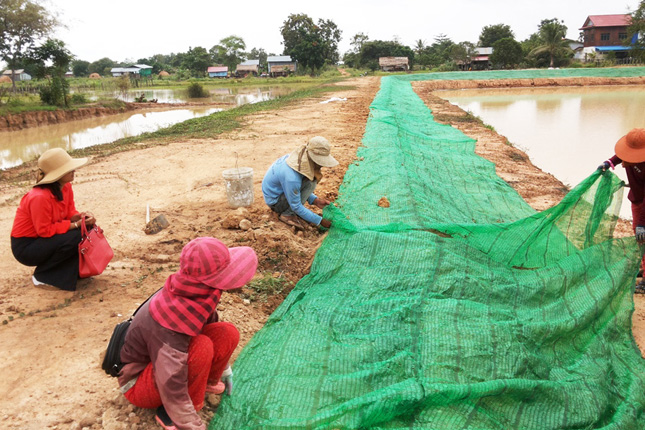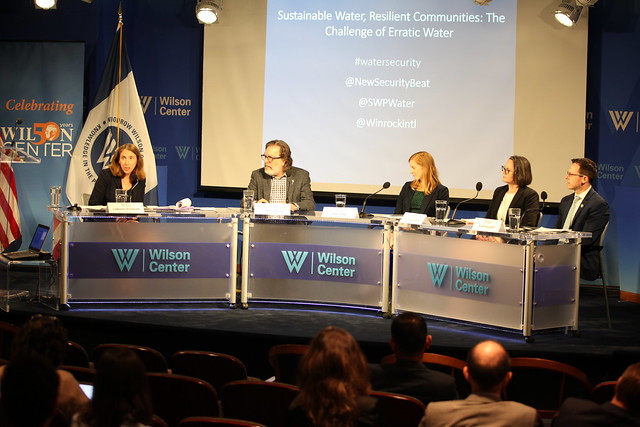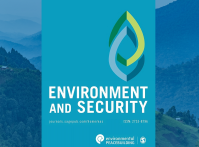-
Sustainable Water, Resilient Communities: The Challenge of Erratic Water
June 7, 2018 By Rebecca Lorenzen
Water variability is increasing “due to climate change and to more frequent natural disasters,” said Jonathan Cook, Senior Climate Change Adaptation Specialist with the U.S. Agency for International Development, at the fourth and final event in a series on water security organized by the Wilson Center and the Sustainable Water Partnership. To solve the problem of increasingly erratic water, “business as usual is really not acceptable anymore,” said Will Sarni, founder of WetDATA.org, who called for new, innovative ideas: “Hope is not a strategy.”
Food and Floods: Challenges
“Agriculture currently uses about 70 percent of the world’s freshwater resources, with only about 10 percent going to cities and residents, and 20 percent going to industry,” said Kate Tully, Assistant Professor of Agroecology at the University of Maryland. Water is “embedded in the foods that we eat,” she said; the most “water hungry” foods—like beef and pork—represent much more water use than poultry and legumes.
Through agricultural products, virtual water moves around the world. “The globalization of trade has decoupled the environmental effects that are a result of our agricultural production from the places that are consuming those products,” said Tully. “We now are relying very heavily on a few water-rich regions to provide most of our food.”
But environmental changes, including climate change, may threaten this reliance. For example, at the current rate of sea-level rise, a good portion of habitable and agricultural land space in Bangladesh will be underwater. In Africa and Asia, eight major crops may be lost by 2050, warned Tully.
Droughts and floods in the United States also threaten trade. The U.S. Army Corps of Engineers, which manages navigable rivers, channels, and dams, can recover from floods relatively quickly, said Kathleen White, the lead of the Corps’ Climate Preparedness and Resilience Community of Practice. But droughts can present significant challenges: If “you can’t get any barges down the river, then there’s a real problem.” Improving the United States’ hydroclimatic forecasts will help improve dam management, she said.
“Hope Is Not a Strategy”: Solutions
To solve these problems, we must “think about 21st century infrastructure, beyond just centralized systems,” said Sarni. The private sector is moving from supply-side concepts like managing water risk to a more proactive approach to water stewardship. But for Sarni, companies should move even further—towards water innovation—by focusing on the opportunities for business growth and value creation.
“Digital water is the game changer in the world of water: applying information and communication technologies to a sector that desperately needs it, so we know how much water we’re using and how we’re using it,” said Sarni. He called for a shift away from “using water once and throwing it away” towards the circular economy concept of “one water,” which involves diversifying sources and “reusing water over and over again” to maximize efficiency.
California’s West Basin Municipal Water District has adopted technological solutions to diversify water sources and ensure a “balanced approach to water reliability,” said Scott Houston, member of the district’s board of directors. The water recycling plant in El Segundo, California, generates water suitable for industrial and agricultural uses and replenishes seawater barriers that prevent saltwater from getting into freshwater aquifers. The district has also launched an ambitious program to test large-scale desalination to increase future supplies.
Smaller-scale solutions can also help mitigate the risks of erratic water. Distributed, off-stream storage—instead of large storage dams—could increase the flexibility to deal with erratic water supplies, said White. Farmers can improve water efficiency by building micro-dams for irrigation or by keeping agricultural land moist through mulching or intercropping, said Tully.
However, any technological solution brought into the developing world should consider the local context. While living in Kenya and Tanzania, Tully saw some projects fail due to lack of local capacity, such as solar-powered micro-irrigation systems scavenged for parts within a year. “You couldn’t even buy the right-size PVC pipe, because they don’t make it in Africa,” she said. In some regions, White pointed out, wells might not be a good solution if the water’s contact with the soil can cause health issues, such as arsenic poisoning.
Overall, we need to embrace holistic solutions that avoid silos and consider perspectives from the economic, policy, technology and business sectors, said Wilson Center Global Fellow Ladeene Freimuth. “These types of solutions—the innovation, the creativity–will be part of creating a more sustainable, resilient, and secure water future for us all.”
Other articles in the Water Security for a Resilient World highlight the connections between water and food security; water as a tool for resilience in times of crisis; enhancing water security and diplomacy in the Mara River Basin; using data to improve water security; the opportunity for innovative financing to expand access to water; the importance of elevating women as water managers; the potential of innovative technologies for global water security; how citizen science can enhance water security; engaging communities to increase water point functionality; water and livelihoods in the Mara River Basin; the hidden forces of water in economic prosperity; and the challenges and opportunities of too little water, too much water, and dirty water.
Sources: Green Biz, LA Times, Sustainable Agriculture Research and Education, UN Climate Change, University Corporation for Atmospheric Research, The Water Channel, West Basin Municipal Water District, World Health Organization
Photo Credit: Promoting Community Resilience to Extreme Weather in Cambodia: Laying Geotextiles, July 2014, courtesy of USAID Asia.
Topics: agriculture, climate change, consumption, data, development, disaster relief, economics, environment, environmental peacemaking, environmental security, featured, flooding, From the Wilson Center, Infrastructure, media, natural resources, risk and resilience, security, video, water, Water Security for a Resilient World
 A Publication of the Stimson Center.
A Publication of the Stimson Center.







